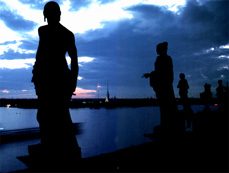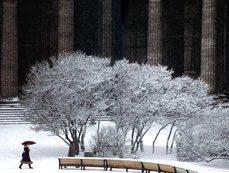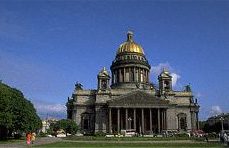 The Hermitage at night | ||||||||||
 Kazan Cathedral | ||||||||||
 St. Isaac's Cathedral | ||||||||||
|
The City Layout
The Admiralty Side
Much of St. Petersburg's historical and cultural heritage is concentrated on the Admiralty Side. The district centres on the Admiralty. This, the nucleus of Peter's original city, was reconstructed in 1806-23 by Andreyan D. Zakharov as a development of the earlier building of Ivan K. Korobov, remodeled in 1727-38, but retaining the layout of the original. Its elegant spire, topped by a weather vane in the form of a ship, is one of the principal landmarks of the city. The building today houses a naval college.
Just to the east lies the great Palace Square, the city's oldest. The 600-ton granite monolith of the Alexander Column (1830-34), the tallest of its kind in the world and so finely set that its base is not fastened, thrusts up for 165 feet (50 metres) near the centre of the square.Between the square and the river rises the huge and massive rectangle of the Winter Palace, the former principal residence of the tsars. The present structure, the fifth to be built, was the Baroque masterpiece of Bartolomeo F. Rastrelli. Construction of it began in 1754 and was completed in 1762. Both the exterior and the interior of the palace were designed in dazzlingly luxurious style. In 1837 the building was destroyed by fire, and only the adjoining Hermitage survived; the Winter Palace was recreated in 1839 almost exactly according to Rastrelli's plans. The striking appearance of the palace is highlighted by white columns against a green background, with golden stucco moldings; 176 sculptured figures line the roof. The whole complex, now called the Hermitage, or State Hermitage Museum, is a treasure-house of fine art of worldwide significance that originated in 1764 as the private collection of the tsarina Catherine II.
Opposite the Winter Palace, the great crescent of Carlo Rossi's General Staff building (1811-29) dominates the square. The two wings of the building are joined by a huge triumphal arch, topped by heroic figures and crowned by a chariot carrying a figure representing Glory, expressing the Russian victory in the campaign of 1812.
On the western (downstream) side of the Admiralty stretches the expanse that was called Senate Square when the Senate moved there in 1763; it is now called Decembrists' (or Dekabrists') Square in commemoration of the revolt in 1825. The buildings of the former Senate and Synod (now housing archives) dominate the western side of the square, their decorated facades dating from the 1830s and representing the last great work of Rossi. They are separated by an arch looking across to the centre of the square where stands the equestrian statue of Peter the Great, known as the "Bronze Horseman" and created in 1782 by Etienne Falconet. Near the Senate and Synod buildings to the south rises the classical front of the Horse Guards Riding School, or Manezh (1804-07); beyond, dominating the south side of St. Isaac's Square, is the cathedral of the same name. An outstanding monument of late classical Russian architecture built by Auguste Montferrand (1818-58), St. Isaac's is one of the largest domed buildings in the world; its golden cupola, gilded with about 220 pounds (100 kilograms) of pure gold, soars to 331 feet in height and is visible all over St. Petersburg. It is now a museum.
From the Admiralty and its surrounding squares radiate three great avenues, of which the most important and best known is the Nevsky Prospekt. One of the world's great thoroughfares, the Nevsky Prospekt cuts southeastward across the peninsula formed by the northward loop of the Neva to the vicinity of the Alexander Nevsky Abbey, crossing the smaller Moyka and Fontanka rivers. The Anichkov Bridge across the latter is graced by four sculptured horses. The street has a special beauty: the architecture is majestic, the buildings are graceful and finely proportioned, the construction is complex. On the Nevsky Prospekt stand the Stroganov, Shuvalov, and Anichkov palaces (former private residences of the nobility) and several churches, of which the most prominent are St. Peter's Lutheran Church (1833-38), St. Catherine's Roman Catholic Church (1763-83), and the Kazan Cathedral (1801-11). The latter edifice, undoubtedly the street's finest feature, was designed by Andrey Voronikhin in Russian classical style and has an interior rich in sculptures and paintings behind a magnificent semicircular frontal colonnade. Another interesting building is the department store Gostiny Dvor (1761-85), originally designed by Jean-Baptiste M. Vallin de la Mothe. This building forms an irregular square and opens onto four streets; formerly it was a mercantile centre. Other department stores line the Nevsky Prospekt, as do many theatres--most notably the Pushkin Academic Drama Theatre--restaurants, and cafes.
At the eastern end of the Nevsky Prospekt, Alexander Nevsky Square fronts the main entrance to the abbey of the same name and its surrounding gardens. Beyond the square's main entrance lie, on the left and right, respectively, monuments and sculptures of the 18th-century Lazarus Cemetery (where Mikhail V. Lomonosov and many of the city's architects are buried) and the 19th-century Tikhvin Cemetery (containing the graves of such writers and composers as Dostoyevsky, Mussorgsky, and Tchaikovsky). Behind rise the spires and cupolas of the Church of the Annunciation (1720, designed by Domenico Trezzini), which is now a museum, and Holy Trinity Cathedral (1778-90, designed by Ivan Starov).
Through the Admiralty Side and intersecting the radial avenues cut the natural channels and canals that so characterize the city. The most important, in outward order from the Admiralty, are the Moyka and Fontanka rivers and the Griboyedov and Obvodny (Bypass) canals. Downstream from the northern entrance of the Fontanka into the Neva lies the Field of Mars, one of the city's beautiful open spaces. Begun under Peter the Great (when it was known as the Field of Amusement), it was intended for popular festivities and fireworks. It was a favourite haunt of the 18th-century nobility, but its present name derives from a monument erected in 1801 and portraying the great Russian military leader Aleksandr V. Suvorov (buried in the Church of the Annunciation) as the god of war. In the 19th century the space was used for military parades and exercises. The fallen of the February Revolution of 1917 and the defenders of the city during the civil war and foreign military intervention (1918-20) were buried there. They are commemorated by an eternal flame.
Just to the east lies the Summer Garden. Founded on an island in 1704, it has parks and gardens that, by the end of the 18th century, contained more than 250 statues and busts, mostly the work of Venetian masters. The Summer Palace, Peter's first in the city, erected 1710-14 in early Russian Baroque style and designed by Trezzini, stands in the northeastern portion.
Next | Main Page | Our Service | Mail Us